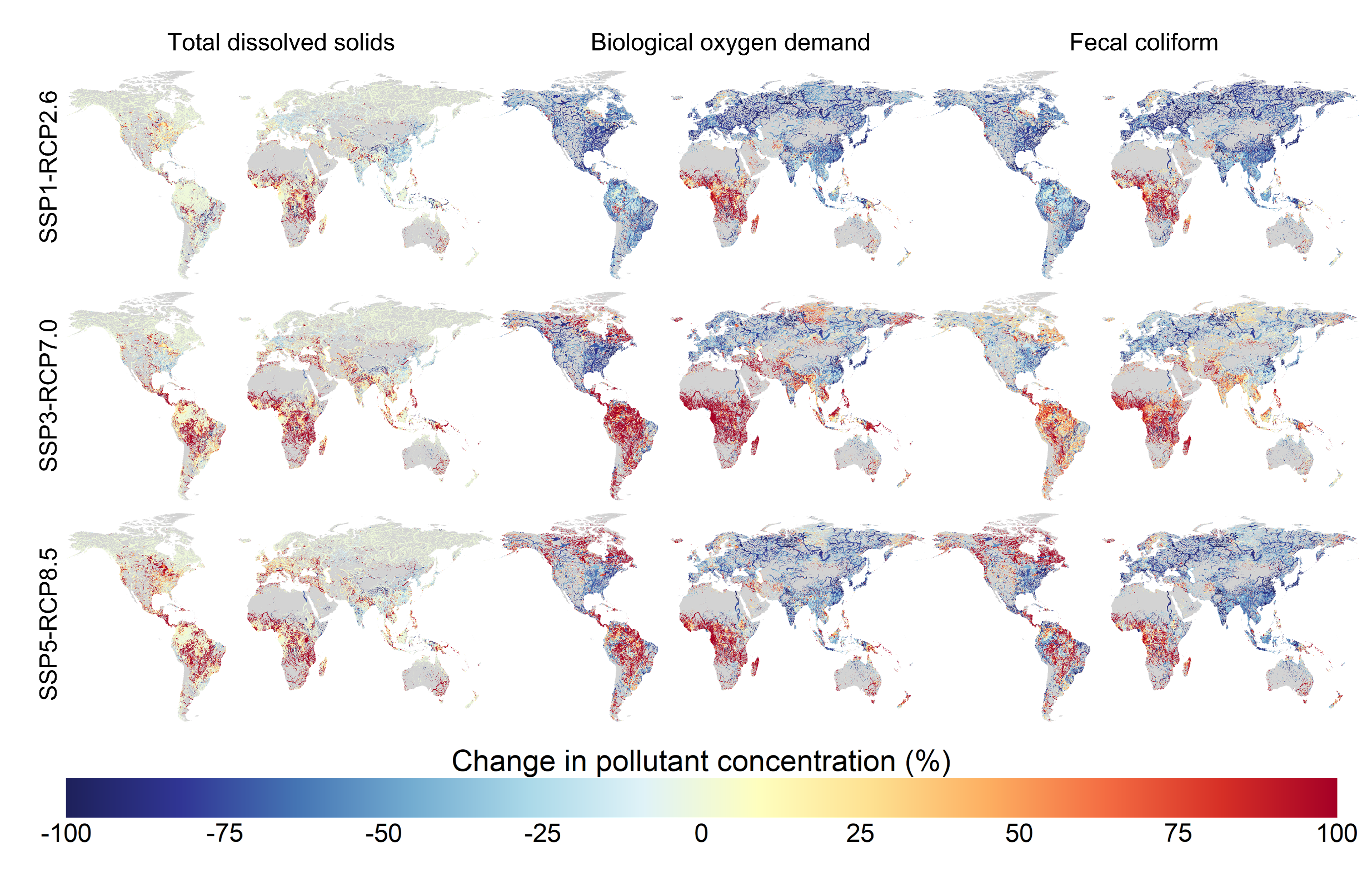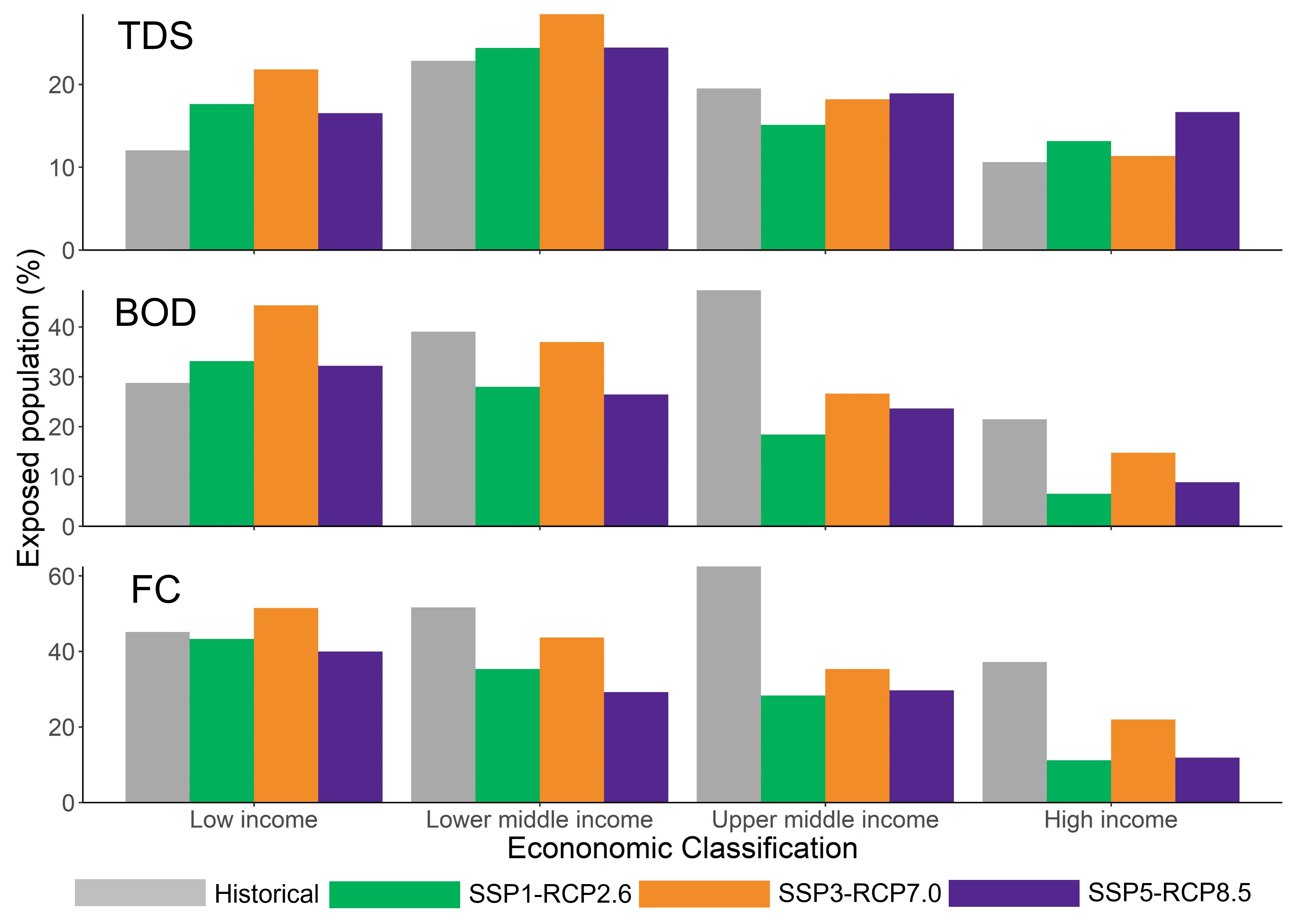Sub-Saharan Africa will increasingly become the dominant hotspot of surface water pollution
Published in Earth & Environment

Access to clean water is fundamental for supporting livelihoods, recognised by the United Nations as a basic human right. Safe use of water – whether for direct consumption as drinking water, irrigating croplands, or for fulfilling our sanitation and hygiene needs – is dependent upon both water availability and quality. Similarly, aquatic ecosystems depend upon clean water resources and can be sensitive to changing environmental conditions.
When our water use is constrained by availability, the implications typically manifest in obvious ways: governments may introduce water rationing, shipping activities get disrupted or become unfeasible and the lack of water for irrigation can place immense pressure on food production. Thermo-electric power production can be hampered by a combination of both low water levels and high water temperatures, leading to reduced electricity output.
Comparatively, the problems of using water of unsuitable quality are more inconspicuous. Yet, the implications can be severe. An estimated 829,000 deaths are attributed to diarrhoea caused by the use of pathogen-contaminated water for drinking or sanitation purposes. Poor sanitation and inadequate water quality are the second and third leading risk factors for childhood stunting. The health and functioning of aquatic ecosystems are particularly sensitive to oxygen concentrations, which are strongly linked to water temperature and the amount of organic matter. Nutrient and pharmaceutical pollution can also pose serious risks. Being under-monitored, difficult to detect and often imperceptible to the human eye, the World Bank has branded water quality issues an “invisible crisis”.
Shedding light on the “invisible”
In-stream water quality sampling and analysis can be both time-consuming and expensive. Thus, observations from water quality monitoring stations are highly limited in space and fragmented across time.
Water quality models are useful tools for supplementing our knowledge of water quality dynamics, which has predominantly been gained from in-stream sampling and analysis. Models offer possibilities to overcome issues related to geographical and temporal coverage, without the requirement for “boots on the ground” to conduct the laborious (and often expensive) tasks of collecting and analysing water samples. The idea of global scale modelling is to use an approach that is consistent across all world regions, in order to facilitate meaningful comparisons of spatial patterns and trends in surface water quality.
Building up: step-by-step
Developing and applying a global scale surface water quality model has been the focus of my research for the past three years. The first step was to develop our model, which simulates multiple water quality constituents that are key indicators of freshwater status, and compare our simulations to observations made in the real world. In a next step, we used our model to explore a “what-if” question related to the current UN target for protecting surface waters. Here, we quantified the impact of achieving this target (halving the proportion of untreated wastewater released to the environment by 2030) on global surface water quality.
In our most recent work, published in Nature Water, we have used our model to make the first projections of global surface water quality until the end of the century.
Projecting future surface water quality
Of course, the future is inherently uncertain. Thus, when making projections of future surface water quality, it is necessary to consider a range of plausible futures about how both climate and society will change over time. Following the approach adopted for the IPCC AR6 report, we use state-of-the-art projections of societal change (e.g. population, land use, economic development) as described by the “Shared socio-economic pathways” (SSPs) and trajectories of climate change (e.g. greenhouse gas concentrations) as described by “Representative concentration pathways” (RCPs), combined in scenario matrix architecture. We consider three diverging scenarios, ranging from a world characterised by sustainability and equality (SSP1-RCP2.6), to resurging nationalism and widening inequality (SSP3-RCP7.0), to strong but fossil-fueled economic development (SSP5-RCP8.5). We consider the impacts of these changes on water temperature and salinity, organic and pathogen pollution as indicated by total dissolved solids (TDS), biological oxygen demand (BOD) and fecal coliform (FC) concentrations, respectively.
Regional divergence, growing inequalities

Strong regional patterns are found in future pollutant concentrations of surface waters (Fig. 1). TDS concentrations are projected to somewhat increase in most world regions, aside from Sub-Saharan Africa (large increases) and East Asia (small reductions). Consistent and strong reductions in BOD and FC concentrations are projected in Western Europe, North America and East Asia under all scenarios. Patterns in other world regions, including Latin America, the Middle East and Southern Asia, are more sensitive to the climate change and socio-economic developments. Conversely, water quality deterioration for all three pollutants are projected for Sub-Saharan Africa, irrespective of climate and socio-economic scenarios.
In general, SSP1-RCP2.6 represents the most optimistic future for surface water quality. Conversely, SSP3-RCP7.0 represents the worst-case scenario combining relatively weak economic development with strong climate change. While strong (fossil-fuelled) economic growth under SSP5-RCP8.5 leads to surface water quality improvements across many world regions, this at the cost of extreme climate change.

The displayed regional patterns are strongly linked to the economic situation of countries (Fig. 2). Strong and robust trends towards surface water quality improvement in the worlds most developed (high income) countries, despite these already being the lowest in the historical period. Similarly, while populations in upper-middle income countries were highly exposed to BOD and FC pollution in the historical period, large reductions are achieved by the end of the century under all three scenarios. Reductions in the percentage of people exposure to BOD and FC pollution are also achieved in many lower-middle income countries, albeit to a lesser extent.
While the simulated improvements to surface water quality in many world regions are a source of optimism, there is an important caveat: the outlook for the poorest nations is much more bleak. Changes to pollutant levels in the least developed (low income) countries are much more sensitive to both climate change and socio-economic developments. Here, exposure to TDS and BOD pollution rise under all scenarios, while there are only moderate changes in exposure to FC pollution. Furthermore, changes in proportional exposure to poor surface water quality is only half the story. With most of the future population growth projected to occur in low to lower-middle income countries, the total number of people exposed to poor surface water quality can drastically increase. This is especially true for Sub-Saharan Africa.
Sub-Saharan Africa is the key future hotspot
Irrespective of climate change and socio-economic scenario, there will be a strong increase in the number of people living in Sub-Saharan Africa who are exposed to poor surface water quality. This pattern is not systematically replicated in any other world region. Even under the most optimistic future scenario (SSP1-RCP2.6) the number of people exposed to TDS, BOD and FC exceedances in Sub-Saharan Africa will more than double. Alternatively, under pessimistic assumptions (SSP3-RCP7.0), the number of people exposed to poor surface water quality can increase 5-fold. With the combination of strong water quality degradation (Fig. 1) and the drastic increases in the number of people exposed to poor surface water quality, our paper concludes that Sub-Saharan Africa will become the key hotspot of surface water pollution in the future.
Follow the Topic
-
Nature Water

This journal publishes research on the evolving relationship between society and water resources on a monthly basis. It covers the natural sciences, engineering, and social sciences, with a particular interest in regards to interdisciplinary research.
Related Collections
With Collections, you can get published faster and increase your visibility.
Water pollution and advanced treatment processes
Publishing Model: Hybrid
Deadline: Feb 28, 2026
Remote sensing and forests
Publishing Model: Hybrid
Deadline: Jan 31, 2026



Please sign in or register for FREE
If you are a registered user on Research Communities by Springer Nature, please sign in